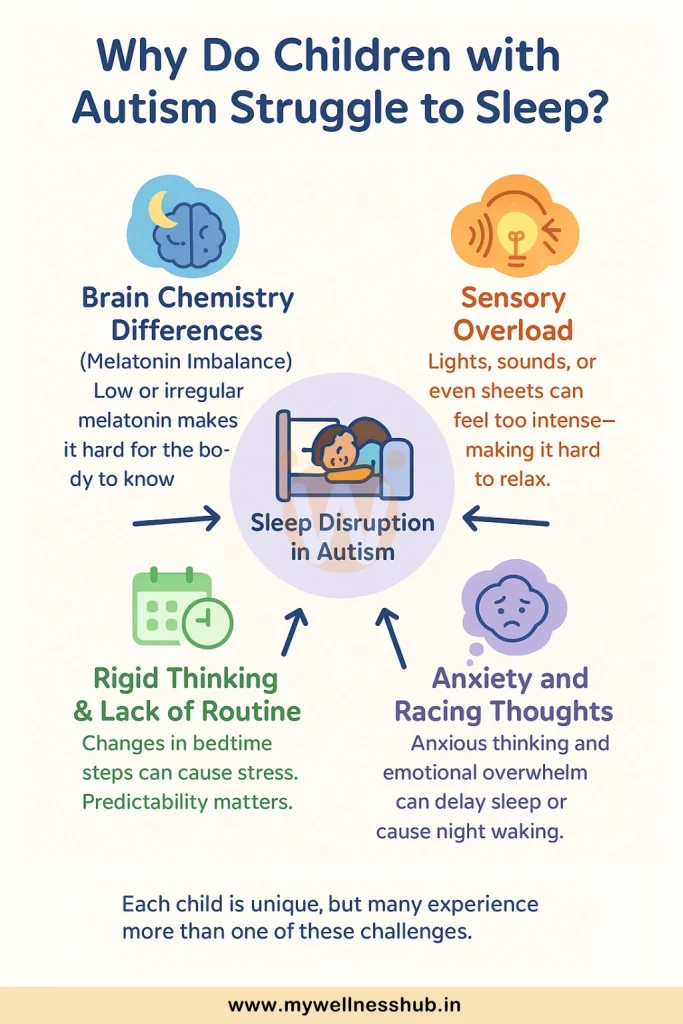Autism and Sleep Problems: Causes, Signs & Tips That Work
By Rajini D
Last Updated: June 6, 2025
Autism and sleep problems often go hand in hand, making bedtime a daily challenge for many families. Whether it’s difficulty falling asleep, waking up frequently, or starting the day too early, sleep struggles can affect a child’s mood, learning, and overall well-being. For parents, it can feel frustrating and exhausting.
In this guide, we’ll explore why autism and sleep problems happen, and share gentle, expert-backed strategies to help your child rest better. We’re here to support you with personalized care and simple solutions that truly work.
Book Free Autism Session
Concerned about your child’s development? Talk to our autism expert online for free. Get personalized consultation and expert next steps.
Why Do Children with Autism Have Sleep Problems?
Sleep can be tricky for many kids—but if you’re raising a child with autism, chances are sleep feels like a never-ending challenge. You’re not alone. Many parents of autistic children notice their little ones either struggle to fall asleep, wake up too often, or start their day way too early.
Let’s break down what makes sleep difficult for children on the autism spectrum—and what might be going on behind those restless nights.

How Autism Affects Sleep Patterns
Autistic children often have different internal rhythms. Their body clocks (called circadian rhythms) don’t always sync well with the day-night cycle, which makes falling asleep or staying asleep harder.
Here’s why:
- They may produce less melatonin (the sleep hormone) or release it at unusual times.
- Their brain wiring processes sensory input differently, which affects how calm or alert they feel.
- They might not pick up on typical cues like “it’s dark, it’s time to sleep.”
Result? They’re awake when they should be winding down, and they might feel sleepy at odd times during the day.
Common Sleep Disorders in Autism
Sleep issues in autistic children can show up in different ways. Here are some of the most common ones:
| Sleep Disorder | What It Looks Like |
|---|---|
| Insomnia | Trouble falling asleep or staying asleep |
| Night Waking | Waking up frequently during the night, often unable to go back to sleep |
| Delayed Sleep Phase | Going to bed very late and struggling to wake up at a typical time |
| Restless Sleep | Tossing, turning, or talking/yelling in sleep |
| Early Morning Waking | Waking up too early and unable to fall back asleep |
Role of Sensory Sensitivities and Overstimulation
Imagine trying to fall asleep while your bedsheet feels scratchy, a tiny fan hum sounds like thunder, and the nightlight is too bright. For children with sensory sensitivities, this isn’t imagination—it’s their reality.
Autistic kids often:
- Notice and react strongly to small sounds, lights, or textures.
- Have trouble filtering out background noise, even when it’s faint.
- Feel overwhelmed by too much sensory input before bed.
What can help?
Creating a calming, sensory-friendly environment is key. Think:
- Soft lighting
- White noise or calming music
- Weighted blankets
- Gentle bedtime activities (e.g., massages, quiet time)
Impact of Anxiety and Rigid Thinking
Another reason sleep becomes tough? Anxiety and rigid routines.
Many autistic children:
- Worry about things they can’t control (like “What if I can’t sleep?”)
- Get anxious when routines change—even bedtime rituals
- Struggle with transitions, including the one from play to sleep
Some common thoughts they might experience:
- “I always need my blue blanket or I can’t sleep.”
- “I didn’t finish my drawing, so I can’t go to bed yet.”
- “If I don’t sleep now, tomorrow will be ruined!”
This kind of thinking can trap them in a loop—and cause nightly meltdowns.
Tip: Building a predictable, visual bedtime routine can reduce resistance and calm their mind.
Know more: Parenting a Child with Autism: Expert Tips for a Calmer Home Life
Signs of Sleep Issues in Autistic Children
If you’re reading this, chances are you’ve noticed your child isn’t sleeping like other kids their age—and you’re wondering if it’s something to worry about. The truth is, sleep disturbances in autism are more common than many people realize.
But how can you tell if your child is truly having sleep problems?
Let’s look at some of the most common signs that your autistic child may be struggling with rest.
Trouble Falling Asleep
Does bedtime turn into a nightly battle?
Many autistic children take a long time to fall asleep, sometimes tossing and turning for hours. You might notice:
- Restlessness in bed
- Wanting to get up multiple times
- Delaying tactics (“Just one more toy!”, “I’m not tired!”)
- Needing the exact same conditions to fall asleep (same blanket, same spot, same light level)
This is often tied to anxiety, rigid thinking, or difficulty winding down. Their brains may still be buzzing, even when their bodies are exhausted.
Waking Up Frequently at Night
If your child wakes up crying or wandering in the middle of the night, you’re not alone.
Autistic children often have fragmented sleep, where they wake up:
- More than twice per night
- At the same time every night
- And have trouble going back to sleep on their own
Sometimes, it’s due to sensory discomfort (like noise or light), nightmares, or even anxiety they can’t express clearly.
This kind of interrupted sleep can affect the entire family—and if it’s happening more than a couple of nights a week, it may be time to seek support from a therapist.
Waking Up Too Early
Some kids wake up before the sun does—and they’re wide awake, ready to go.
While it may sound harmless, early morning waking in autistic children can:
- Leave them sleep-deprived (if they went to bed late)
- Cause exhaustion by mid-morning
- Create issues with focus and behavior throughout the day
This might be linked to a delayed sleep cycle, or their internal body clock being out of sync. A predictable sleep schedule and a calm wind-down routine can help adjust this over time.
| Behavior Sign | What You Might Notice |
|---|---|
| Mood Swings | More frequent meltdowns, irritability, or sadness |
| Hyperactivity | Constant movement, trouble sitting still |
| Poor Focus | Zoning out or difficulty finishing simple tasks |
| Increased Stimming | Rocking, hand-flapping, or repetitive speech increases |
| Aggression or Shutdowns | Lashing out or completely withdrawing |
How Poor Sleep Affects Kids with Autism
It’s easy to assume that a rough night of sleep will just pass. But when sleep problems become a regular thing, they start to affect more than just the night. For autistic children, the daytime effects of poor sleep can be especially hard on their mood, learning, and relationships.
Let’s look at what happens when a child on the spectrum isn’t getting enough rest—and how it can show up in ways you might not expect.
Daytime Fatigue and Irritability
You know the signs—your child wakes up groggy, rubs their eyes, and seems frustrated before the day even begins. Many autistic kids struggle with fatigue during the day because their sleep is so broken at night.
Some common signs of sleep-related fatigue:
- Sluggish movement or dragging their feet
- Refusing to participate in morning tasks
- Becoming irritable or cranky over small things
- Looking “wired but tired”—appearing hyper but actually overtired
This kind of tiredness isn’t just physical. It also makes it harder for your child to self-regulate emotions.
Increased Meltdowns and Aggression
One of the biggest links between autism and behavior issues is sleep.
When kids don’t get the rest they need, their ability to manage emotions goes down fast. You might see:
- More frequent meltdowns during transitions
- Sudden aggression (hitting, biting, throwing things)
- Loud outbursts or yelling when frustrated
- Tearful breakdowns over minor changes
Poor sleep can shrink their tolerance for noise, lights, or even basic requests like “put your shoes on.”
These signs are often misunderstood as defiance—but in reality, they’re often the result of an overwhelmed, overtired brain trying to cope.
Attention and Learning Problems
Another major issue? Sleep and developmental delays often go hand in hand.
When a child doesn’t sleep well:
- Their focus and memory are affected
- They may struggle with language learning or communication
- Therapy sessions can become less effective due to low attention
- School performance may drop, even if they’re trying their best
| Sleep Issue | Impact on Learning |
|---|---|
| Frequent waking at night | Poor memory retention and recall |
| Delayed sleep phase | Trouble attending morning classes or therapy sessions |
| Short sleep duration | Slower language development and poor task completion |
Family Stress and Caregiver Burnout
Let’s be honest: it’s not just the child who suffers.
Parents and caregivers are deeply affected when sleep becomes a nightly struggle. The whole household feels it.
Common effects of sleep challenges on families:
- Exhaustion and burnout in parents
- Increased arguments or tension at home
- Feelings of guilt, helplessness, or worry
- Disrupted routines for siblings
Many parents say they feel like they’re “just surviving” day to day.
What Causes Sleep Problems in Autism?
By now, you might be wondering: Why is sleep so difficult for my autistic child? You’re doing your best—maybe you’ve tried a set bedtime, calming routines, even white noise—and yet, nothing seems to stick.
The truth is, sleep disruption in ASD isn’t caused by just one thing. It’s often a mix of internal and external factors that make it harder for autistic kids to fall and stay asleep.
Let’s walk through the most common causes.
Brain Chemistry Differences (Melatonin)
Melatonin is a natural hormone that tells our bodies when it’s time to sleep. But research shows that many children with autism don’t produce enough melatonin, or they produce it at the wrong times.
This imbalance can lead to:
- Delayed sleep (your child takes hours to fall asleep)
- Irregular sleep cycles (waking up during the night)
- Trouble knowing when it’s time to rest or be active
| Melatonin Issue | Possible Effect on Sleep |
|---|---|
| Low melatonin production | Hard to fall asleep naturally |
| Irregular melatonin rhythm | Waking up at odd hours, disrupted sleep cycle |
Sensory Processing Challenges
Imagine trying to sleep in a room that feels too bright, too itchy, too noisy, or just overwhelming. That’s what it’s like for many autistic children with sensory processing differences.
They may be:
- Overly sensitive to noise (like a ticking clock or fan hum)
- Bothered by certain textures (bed sheets, pajamas)
- Unsettled by dim light, complete darkness, or even a flickering lamp
These sensory issues can make bedtime stressful instead of relaxing, and lead to sleep avoidance.
What helps? Creating a sensory-friendly sleep space, such as:
- Soft bedding and preferred fabrics
- Consistent white noise
- Weighted blankets (if calming)
- Dimming lights gradually instead of turning them off abruptly
Lack of Routine and Predictability
Many children with autism thrive on structure. When the day—or especially the night—feels unpredictable, it can cause distress and delay sleep.
You might notice:
- Resistance at bedtime when the routine changes
- Anxiety if one step is skipped (e.g., no bedtime story)
- Difficulty transitioning from play to sleep
A solid bedtime routine that follows the same pattern each night can be one of the most powerful tools to reduce sleep anxiety.
Co-existing Conditions (like ADHD, anxiety)
Sleep problems in autism can also be linked to other co-occurring conditions. It’s very common for children on the spectrum to have:
- ADHD – which causes hyperactivity, racing thoughts, and restlessness
- Anxiety – which makes it hard to “shut off” at night
- Sensory integration disorder, GI issues, or even seizure disorders
| Condition | Sleep Disruption Type |
|---|---|
| ADHD | Trouble settling down, waking up early |
| Anxiety | Worry at bedtime, fear of sleep, frequent night waking |
| GI discomfort | Waking due to bloating, gas, or constipation |
Addressing these underlying conditions can make a huge difference in reducing sleep problems. Therapy, calming techniques, and in some cases, medication can help—but only when tailored to your child’s needs.
Sleep Solutions for Autistic Children That Actually Work
If you’ve been struggling to get your autistic child to sleep—and stay asleep—you’re not alone. The good news? There are ways to make bedtime smoother, more predictable, and less stressful for everyone involved.
Let’s look at some simple, proven sleep strategies for autism that can truly make a difference—many of which parents have used successfully with support from therapists at Wellness Hub.
Importance of a Consistent Bedtime Routine
Autistic children thrive on routine—especially at night. A predictable bedtime routine tells their brain: “It’s time to slow down now.”
Why it works:
- Reduces anxiety and bedtime resistance
- Helps the body prepare for sleep naturally
- Builds sleep cues (e.g., bath means bedtime is near)
Tips to make it work:
- Use a visual bedtime schedule with pictures
- Keep the order and timing the same every night
- Start winding down at the same time every evening
Sensory-Friendly Sleep Environment
Some children can fall asleep anywhere. Autistic children? Not so much. That’s because many have sensory sensitivities that make their bedroom feel overwhelming.
Creating a calm, sensory-friendly sleep environment can help your child feel safe and relaxed.
| Element | What to Try |
|---|---|
| Lighting | Dim lamps, warm lights, or gradual dimming |
| Sound | White noise, nature sounds, or silence (based on preference) |
| Touch | Soft bedding, preferred textures, or weighted blanket |
| Smell (optional) | Lavender oil or calming scents (only if your child likes it) |
| Visual clutter | Keep the space minimal and organized |
Relaxation and Calming Techniques
Sometimes, it’s not the environment—it’s the mind that won’t switch off.
If your child struggles to wind down, you can gently introduce calming techniques before bed:
- Deep pressure massage or firm hugs
- Breathing exercises (e.g., “smell the flower, blow out the candle”)
- Listening to slow, rhythmic music
- Reading calming or repetitive books
- Rocking or using a gentle swing before bed
Try different things to see what works for your child. Every child is unique—especially when it comes to autism and sleep.
Safe Use of Melatonin and Natural Remedies
Melatonin is a popular option among parents wondering how to help an autistic child sleep—but it’s important to use it wisely.
Here’s what to know:
- Melatonin is not a sedative, but it helps regulate the body clock
- It may be helpful for falling asleep, but won’t always prevent night waking
- Always speak to your pediatrician before starting it
- Other gentle, natural remedies to explore:
- Magnesium-rich foods (like bananas) for calming the nervous system
- Warm milk or a light bedtime snack (avoid sugar)
- Herbal teas (like chamomile – only if age-appropriate)
Behavioral Approaches and Sleep Training
Sometimes, children get used to needing a parent next to them to fall asleep—or waking up and calling out each night. In such cases, a gentle behavioral approach can help them learn more independent sleep habits.
Techniques may include:
- Gradual fading (staying nearby at first, then slowly reducing presence)
- Bedtime pass (for limited, predictable interaction after lights out)
- Reward systems (small rewards for staying in bed all night)
- Scheduled waking (to help reduce night waking over time)
Sample Bedtime Routine for Kids with Autism
If your evenings feel chaotic, you’re not alone. Many parents say bedtime is the hardest part of the day—especially when routines don’t stick or keep changing. The key to smoother nights? A predictable, step-by-step bedtime routine built specifically for your child’s needs.
Let’s walk through a simple, visual bedtime routine that supports your child’s comfort and creates a peaceful end to the day.
Step-by-Step Visual Sleep Routine
Children on the autism spectrum often respond well to visual schedules—they help them know what’s coming next, which reduces anxiety and bedtime battles.
Here’s a sample sleep schedule for autism that you can adapt at home:
| Time | Activity | Visual Cue/Support |
|---|---|---|
| 7:00 PM | Brush Teeth | Toothbrush, favorite toothpaste |
| 7:20 PM | Bath Time | Picture of a bathtub, calming lavender bubbles |
| 7:30 PM | Calm Down Activity | Quiet game, light stretching, or deep breathing |
| 7:45 PM | Story or Audiobook | Favorite book cover image or headphones |
| 8:00 PM | Lights Dim | Lamp icon or smart bulb color change |
| 8:15 PM | Bedtime | Picture of bed with soft toy, starry sky |
Tips for Transitions and Predictability
Smooth transitions help your child feel safe and in control. Sudden changes or rushed routines can lead to meltdowns or bedtime refusal.
Here’s how to make transitions easier:
- Give advance warnings: “In 5 minutes, it’s time to stop playing and start your bath.”
- Use timers or countdown songs to signal change
- Offer choices within structure: “Do you want the blue towel or the green one?”
- Stick to the same order every night—this builds trust and predictability
Use of Visual Schedules and Social Stories
Visual aids are not just for schools—they’re powerful tools at home, especially for autistic kids.
Here’s what you can try:
Visual Bedtime Schedules
- Use pictures, emojis, or icons to represent each step
- Keep it in a visible spot (bedroom wall, bathroom door)
- Let your child check off each step—they’ll love the sense of progress
Social Stories
A social story is a short, personalized story that helps explain:
- Why we sleep
- What happens during bedtime
- How sleep helps the body and mind
Natural Sleep Aids and Therapies to Consider
Not every solution has to come in a bottle or prescription. In fact, many families find that natural sleep remedies for autism—when used consistently—can make a big difference in how easily their child falls asleep and stays asleep.
Let’s explore gentle, safe options that can support better rest without overwhelming your child’s senses.
Weighted Blankets and Sensory Tools
For kids with autism, the feeling of deep pressure can be incredibly calming. That’s where weighted blankets and sensory tools come in.
How they help:
- Provide a sense of security and comfort
- Help reduce restlessness and anxiety
- Support the body in transitioning into sleep mode
| Tool | Use Case |
|---|---|
| Weighted Blanket | Promotes stillness and calm at bedtime |
| Compression Sheet | Offers a gentle “hug” feeling while sleeping |
| Fidget Toys (before bed) | Helps release extra energy in a focused way |
Some kids love these tools, others might not. The key is to let your child explore gently and observe what feels comforting.
Music and Sound Machines
For children who are sensitive to noise—or who have trouble shutting off their thoughts—soothing sound can be a game-changer.
Try:
- White noise (fans, ocean waves)
- Slow instrumental music or lullabies
- Nature sounds (rainfall, birds, wind)
Benefits:
- Drowns out background distractions
- Sets a predictable sleep cue
- Helps signal to the brain that it’s time to relax
Tip: Keep the volume low and steady. Avoid sudden sounds or unpredictable playlists.
Aromatherapy (Lavender, Chamomile)
Smell is a powerful sensory tool, and aromatherapy can be part of your child’s nighttime wind-down routine.
Gentle, calming scents like:
- Lavender – known for promoting calm and relaxation
- Chamomile – often used for its soothing, sleepy properties
- Sandalwood or cedarwood – grounding scents for deeper rest
Ways to use:
- A few drops in a diffuser
- Scented bedtime spray (on pillow or blanket)
- Gentle massage oil during wind-down time
Always check for allergies or sensitivities first. Keep it subtle—too strong can be overstimulating.
Melatonin – When and How to Use Safely
Many parents ask about melatonin when nothing else seems to work. It’s a natural hormone that tells the body it’s time to sleep—but in some autistic children, melatonin levels are low or out of sync.
Here’s what you should know:
- Melatonin is generally safe for short-term use, especially when guided by a pediatrician
- It’s most effective for falling asleep, not staying asleep
- Start with low doses (often under 1mg)
- Timing matters: usually 30–60 minutes before bedtime
| Melatonin Tip | Why It Matters |
|---|---|
| Stick to same time nightly | Helps set internal clock |
| Avoid screens before bedtime | Blue light interferes with melatonin naturally |
| Use alongside a solid routine | Works better with calming bedtime structure |
Melatonin isn’t a fix-all, but when used as part of a larger autism therapy for sleep, it can support better rest.
Conclusion:
Sleep problems are common in children with autism—but there’s hope. With calming routines, sensory-friendly sleep spaces, and gentle tools like melatonin or visual schedules, better sleep is possible. Good rest helps your child feel happier, more focused, and ready to learn. And it brings peace to the whole family too. At Wellness Hub, we support parents with expert advice and personalized therapy to make bedtime easier. You don’t have to struggle alone—we’re here to help.
Frequently Asked Questions:
1. Why do children with autism have trouble sleeping?
Children with autism often face sleep challenges due to factors like irregular melatonin levels, sensory sensitivities, anxiety, and difficulty with changes in routine.
2. What are common sleep problems in autistic children?
Common sleep issues include difficulty falling asleep, frequent night awakenings, early morning waking, and restless sleep.
3. How can I help my autistic child sleep better?
Establishing a consistent bedtime routine, creating a calming sleep environment, limiting screen time before bed, and using visual schedules can aid in improving sleep.
4. Is melatonin safe for children with autism?
Melatonin is often used to help autistic children with sleep issues. Consult with a healthcare provider to determine the appropriate dosage and monitor for any side effects.
5. Can sensory issues affect my child’s sleep?
Yes, sensory sensitivities to light, sound, or touch can make it harder for autistic children to fall and stay asleep. Adjusting the sleep environment can help.
6. How much sleep does an autistic child need?
Sleep needs vary, but generally, school-aged children require 9–11 hours of sleep per night. Autistic children may need similar amounts, but individual needs can differ.
7. What bedtime routine is best for autistic kids?
A predictable routine might include activities like a warm bath, brushing teeth, reading a story, and dimming lights, helping signal it’s time to sleep.
8. Do sleep problems in autism affect daytime behavior?
Yes, poor sleep can lead to increased irritability, difficulty concentrating, and more pronounced repetitive behaviors during the day.
9. Should I consider sleep therapy for my autistic child?
Sleep therapy can be beneficial. Consulting with specialists can provide strategies tailored to your child’s needs.
10. Where can I find support for autism and sleep issues?
Organizations like Autism Speaks and the National Autistic Society offer resources. Additionally, consulting with pediatricians or sleep specialists can provide personalized guidance.
About the Author:
Rajini Darugupally
M.Sc., Speech-Language Pathologist (9+ years of experience)
Rajini is a passionate and dedicated Speech-Language Pathologist with over 9+ years of experience, specializing in both developmental speech and language disorders in children and rehabilitation in adults. Driven by a desire to empower each individual to find their voice, Rajini brings a wealth of experience and a warm, genuine approach to therapy. Currently, at Wellness Hub, she thrives in a team environment that values innovation, compassion, and achieving results for their clients.
Book your Free Consultation Today
Parent/Caregiver Info:
Client’s Details:
* Error Message








